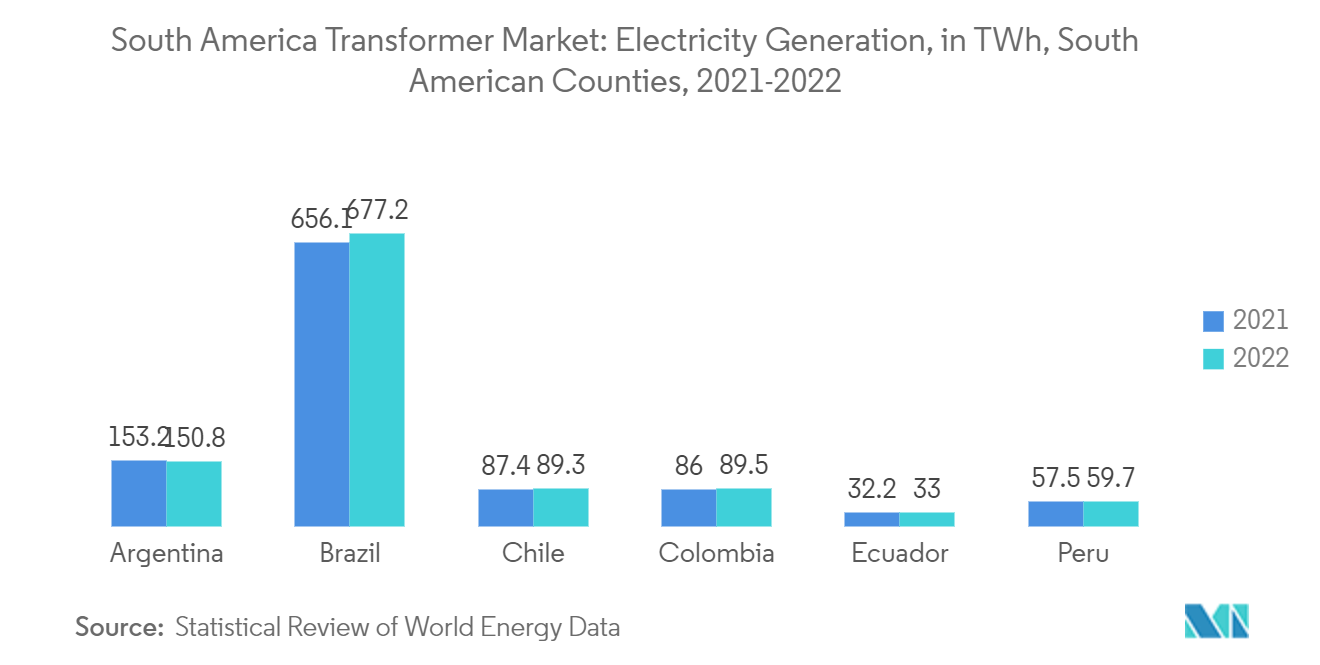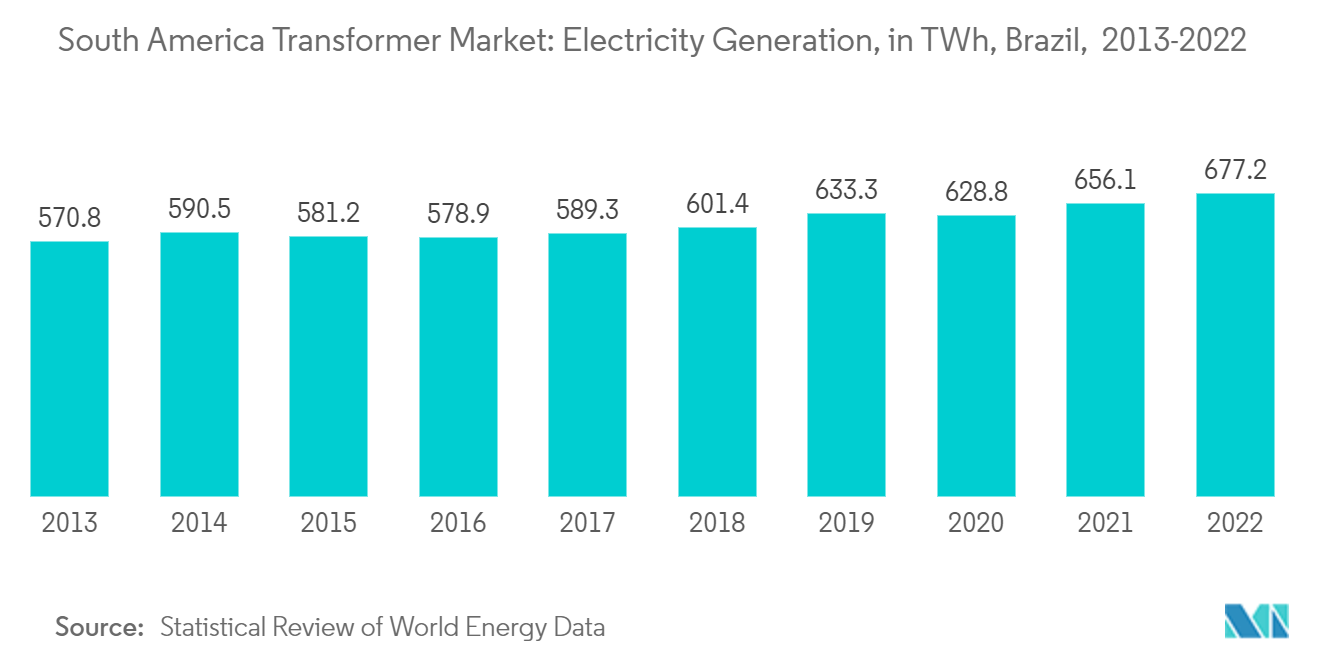Market Trends of South America Transformer Industry
Air-cooled Segment is Expected to Dominate the Market during the Forecast Period
- A dry-type transformer or air-cooled transformer is a type of transformer that uses air as a coolant. A dry-type transformer has no moving parts and is a static device that uses eco-friendly temperature insulation systems. The dry-type transformer is more eco-friendly compared to the oil-filled type transformer. It is less flammable and poses a lesser fire risk. It is employed in various applications, including high-rise buildings, airports, stadiums, hotels, shopping malls, chemical and refinery plants, substations for interior cities, rural areas, and residential complexes.
- The ongoing industrialization in South America in countries like Argentina and Brazil is a crucial driver for the air-cooled transformers market. As industries expand and diversify, the demand for reliable and robust electrical systems is likely to increase. Air-cooled transformers, with their ability to efficiently handle varying loads and environmental conditions, are well-suited to meet the challenges posed by industrial applications.
- Government initiatives to promote energy efficiency and sustainability have been a major factor in the growth of the air-cooled energy transformer market. Manufacturers have been striving to improve the efficiency and performance of their transformers, leading to a surge in technological innovation.
- This industrial growth, coupled with the development of smart grids and renewable energy projects, is expected to boost the market for air-cooled transformers in the region. For instance, in August 2023, GE Vernova announced that its subsidiary Grid Solutions had signed a contract with Casa dos Ventos for the construction of two 500 kV air-insulated substations (AIS) for the Serra do Tigre Wind Complex located in the municipalities of Sao Tome and Currais Novos in the state of Rio Grande do Norte.
- For instance, in November 2023, Atlas Renewable Energy announced that the company had secured USD 447.8 million from the Brazilian Development Bank (BNDES) to develop a 902MW single-phase project in Brazil.
- According to the Statistical Review of World Energy Data, in South America, the share of electricity generation increased by 2.6% in 2022 compared to 2021. The demand for dry-type transformers over the past years has been driven by the increasing demand for electricity on account of urbanization and industrialization, coupled with the low daily maintenance cost of dry-type transformers, especially in countries like Brazil, Colombia, Ecuador, and Chile.
- Overall, the demand for air-cooled transformers is expected to increase during the forecast period as the need for power T&D infrastructure increases in South America, coupled with the advantages of the air-cooled transformer to be used in commercial and residential places without many hazards and environmental damage.

Brazil is Expected to Witness Significant Growth during the Forecast Period
- Brazil is the largest energy consumer in South America. Like Argentina, the country's energy sector mainly relies on thermal power plants (including oil, natural gas, and coal). According to the Statistical Review of World Energy, in 2022, nearly 50.3% of the total energy consumed in Brazil was generated from thermal power plants, while the rest was generated through nuclear and renewable.
- Transportation and industry are the two most significant sectors that account for 75% of final energy consumption in Brazil. According to the International Energy Agency (IEA), in the Stated Policies Scenario (STEPS), the country is expected to witness 30% growth in energy consumption by 2050, with most demand coming from the industries.
- In 2022, the country had more than 150 GW of power generating capacity, which generated nearly 677.2 terawatt-hours (TWh) of electricity. Hydroelectric was the most utilized sector in the country, generating nearly 63% of the total electricity in 2022. Among the other sectors, renewable generated around 24.2% of the electricity, while the rest was generated from thermal and nuclear power plants.
- Growth in generation capacity is likely to increase investment in transmission and distribution grid infrastructure. Under the 10-year expansion plan (PDE 2029) published by the Brazilian Energy Research Agency (EPE), the country is expected to invest around USD 20 billion in the electricity transmission sector until 2029. Out of the total investment, nearly USD 14 billion will be in the transmission lines, while the remaining is expected to be in the substations.
- In July 2022, the Brazilian Electricity Regulatory Agency (ANEL) awarded 13 power transmission projects with more than 5,425 km of lines, requiring a total investment of USD 2.9 billion. The projects are likely to transmit renewable energy and are expected to be built in the Acre, Pará, Amapá, Amazonas, Bahia, Mato Grosso, Mato Grosso do Sul, Rondônia, Santa Catarina, Minas Gerais, São Paulo, Espírito Santo, and Sergipe.
- In July 2023, Engie was selected to build more than 1,000 km of power transmission lines in the country. The company received a 30-year concession to design, construct, and offer operations and maintenance of the transmission lines in the states of Bahia, Minas Gerais, and Espírito Santo. The estimated investment of the project would be around USD 557 million.
- The Brazilian Ministry of Mines and Energy also initiated a public consultation on the Ten-Year Energy Expansion Plan 2031, which foresees the investment of USD 97 billion in the electricity sector over 2021-2031, including USD 54 billion in centralized generation, USD 25 billion in distributed generation, and USD 19 billion in transmission.
- Thus, such investments in transmission line projects are anticipated to create demand for transformers in Brazil in the upcoming years.

